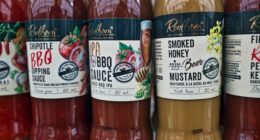Chilling preserves food at temperatures just above freezing to slow bacterial growth, while freezing uses lower temperatures to completely halt it.
TL;DR Freezing Vs. Chilling
Chilling refers to storing food at a temperature just above freezing, typically around 32°F (0°C). This method slows down bacterial growth and extends the shelf life of perishable items like fruits, vegetables, dairy products, and cooked meats.
Freezing involves reducing the temperature below the freezing point of water (32°F or 0°C) to solidify moisture in foods. Freezing halts microbial activity almost entirely by placing bacteria in a dormant state.
What is freezing?

Freezing is a process that involves lowering the temperature of a substance until it solidifies. When something freezes, the water molecules within it slow down and arrange themselves into a crystalline structure.
This transformation results in the formation of ice.
Freezing is commonly used to preserve food by slowing down bacterial growth and enzyme activity. By reducing the temperature, microorganisms become dormant, preventing spoilage and extending shelf life.
What is chilling?
Chilling refers to the process of cooling food or drinks to a temperature just above freezing, typically between 32°F (0°C) and 40°F (4°C). This method helps slow down the growth of bacteria and preserves the freshness of perishable items.
Chilling involves placing food or beverages in a refrigerator or cooler. The cold temperature inhibits bacterial growth, extending the shelf life of products. It is commonly used for storing fruits, vegetables, dairy products, meats, and leftovers.
Freezing Vs. Chilling – Key differences
Freezing
- Temperature: Involves lowering the temperature of food below 0°C (32°F) to freeze it solid.
- Purpose: Freezing stops bacterial growth, preserving food for extended periods.
- Effect on Texture: Freezing can alter the texture of some foods due to ice crystal formation.
- Storage: Frozen food can be stored for long periods, often several months, without significant deterioration.
Chilling
- Temperature: Involves cooling food to just above freezing, typically between 0°C to 4°C (32°F to 39°F).
- Purpose: Chilling slows bacterial growth, extending the shelf life of food but not preserving it for long periods.
- Effect on Texture: Chilling generally has a minimal impact on the texture of most foods.
- Storage: Chilled food should be consumed relatively quickly, usually within a few days, for best quality and safety.
Freezing uses much lower temperatures to preserve food for long-term storage, while chilling slightly above freezing extends shelf life but does not preserve as extensively.
Image Credits
Featured Image By – rawpixel.com on Freepik
Image 1 By – Houstomwinsha Konglampo, CC BY-SA 4.0, via Wikimedia Commons








